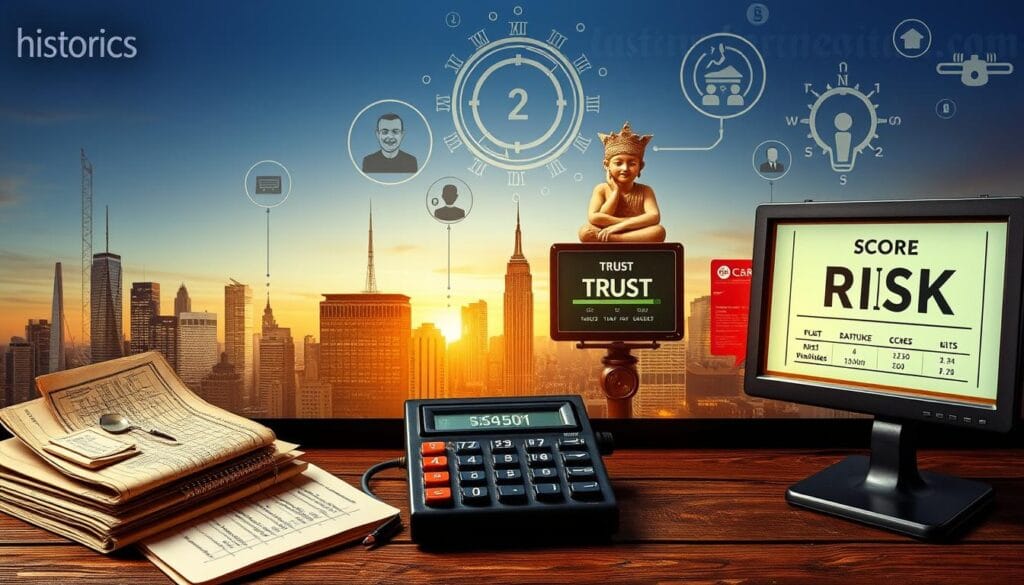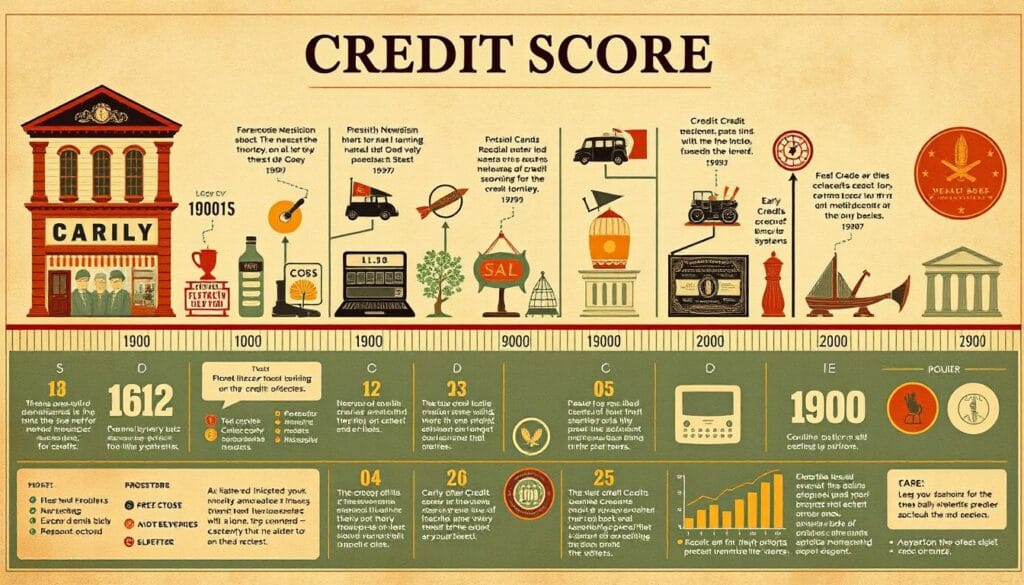Credit scores are now a big part of our financial lives. They help us get loans and mortgages. But, have you ever thought about where they came from? Let’s dive into the history of credit scores and see how they’ve changed over time.
Key Takeaways
- Credit scoring started in the early 20th century. Lenders wanted a better way to check if people could pay back loans.
- Switching from manual checks to automated scores changed the game. This is when credit scoring became what we know today.
- The Fair Isaac Corporation was key. They created the first FICO score. This was a big step in credit scoring history.
- New tech has made credit scoring smarter. It uses more data and predicts better.
- Rules and laws have also shaped credit scoring. They help protect us and make the system fairer.
The Birth of Modern Credit Assessment
As the world moved from the pre-industrial era, how we check credit changed a lot. No more guessing or personal opinions. Now, we use a clear, detailed way to see if someone can be trusted with money. This change led to the start of early days of credit scoring and the development of the first credit score system.
Pre-Industrial Credit Evaluation Methods
In the old days, people trusted each other more. Lenders knew borrowers through personal connections and what they looked like. This worked well in small towns but failed as cities grew and money matters got more complex.
Transition to Systematic Credit Analysis
The transition to systematic credit analysis started in the 19th century. The financial world was getting too big for simple guesses. So, lenders started looking for ways to use facts to figure out who to trust with money.
Early Credit Reporting Agencies
- The first credit reporting agencies, like Dun & Bradstreet, were key in the development of the first credit score system. They gathered and sorted out financial info, helping lenders make better choices.
- These early agencies were a big step forward in credit score development. They set the stage for how we check credit today.
The move from old ways to new, fact-based methods was a big step. It helped start the early days of credit scoring and led to the systems we use now.

When Were Credit Scores Invented: A Timeline Overview
The history of credit scores in the U.S. is fascinating. It shows how credit scoring milestones have changed the industry. From old ways of checking credit to today’s digital methods, this timeline is a deep dive into the evolution of credit scores and their credit score history.
- Pre-Industrial Credit Evaluation (1800s): Back then, people relied on personal recommendations and collateral to get loans. It was all about trust and security.
- Transition to Systematic Credit Analysis (Early 1900s): Credit bureaus started, and credit reporting became more organized. This was a big step towards using data to judge creditworthiness.
- Formation of the Fair Isaac Corporation (1956): Bill Fair and Earl Isaac founded the Fair Isaac Corporation. They created the first widely used credit scoring model.
- Introduction of the FICO Score System (1989): The FICO score system became the go-to for lenders. It gave a clear way to judge creditworthiness.
- Advancements in Credit Scoring Technology (1990s-2000s): The digital age brought better credit scoring models. These were more accurate and efficient.
- Regulatory Changes and Consumer Protection (2000s-present): Laws like the Fair Credit Reporting Act and the Dodd-Frank Act have protected consumers. They ensure credit scoring is fair and transparent.
This timeline is a detailed look at the credit scoring milestones and the evolution of credit scores in the U.S. It shows how this important financial tool has grown and changed over time.

“The credit scoring industry has come a long way since its early beginnings, adapting to technological advancements and evolving consumer needs to become an integral part of the modern financial landscape.”
The Role of Bill Fair and Earl Isaac
Bill Fair and Earl Isaac are the pioneers behind today’s credit scores. They played a key role in creating the FICO score system. Their work changed how we view credit scores.
Formation of the Fair Isaac Corporation
In 1956, Bill Fair and Earl Isaac started the Fair Isaac Corporation, now known as FICO. This company changed the game for lenders. They introduced the first credit scoring model.
Development of the First Scoring Model
They created the first credit scoring model using statistics. This model, the FICO score, became the standard. It made automated credit checks common.
Implementation Challenges and Solutions
Introducing this new method faced many hurdles. Fair and Isaac faced doubt from old-school lenders. But, their hard work and results won over the industry.

“The FICO score revolutionized the way lenders evaluated creditworthiness, making credit more accessible and paving the way for the modern financial ecosystem.”
Bill Fair and Earl Isaac were true pioneers in credit scores. Their work on the FICO score system is foundational. It has shaped our financial world today.
Evolution From Manual to Automated Credit Scoring
Credit scoring has changed a lot, moving from manual to automated systems. This change has made the credit industry more efficient, accurate, and fair. It has also made lending decisions better.
Before, checking credit was hard work. Lenders had to look at each application carefully. They would check the applicant’s financial history and personal info to decide if they could lend.
But now, thanks to evolution of credit scores and data analytics, things are different. Automated credit scoring uses advanced algorithms and lots of data. This makes it easier and more reliable for lenders to decide who to lend to.
These systems quickly look at a person’s credit history and how they pay bills. They also check other things to make a detailed credit score development profile. This helps lenders make quick, fair decisions. It also means more people can get credit when they need it.
But, moving to automated scoring has brought challenges. Lenders and consumers have worried about fairness and bias. But, updates and rules have helped make the system better and fairer for everyone.
“The evolution of credit scoring has been a game-changer, transforming the way lenders evaluate risk and making credit more accessible to millions of consumers.”
The credit industry is always getting better with new tech. The evolution of credit scores and automated credit scoring will keep playing a big role. They will help shape the future of personal finance and lending.
| Manual Credit Evaluation | Automated Credit Scoring |
|---|---|
| Labor-intensive process | Rapid, efficient assessment |
| Subjective, prone to bias | Objective, data-driven analysis |
| Limited data sources | Vast troves of consumer data |
| Slow decision-making | Expedited lending decisions |
Introduction of the FICO Score System
The FICO score system started with the FICO score, a big change in how lenders check credit. It’s a number that shows how likely someone is to pay back their debts. This score comes from a special formula that looks at many parts of a person’s credit history.
Components of the Original FICO Score
The first FICO score had a few main parts:
- Payment history: This part is 35% of the score. It checks if you pay on time.
- Amounts owed: This part is 30% of the score. It looks at how much debt you have and how much credit you use.
- Length of credit history: This part is 15% of the score. It sees how long you’ve had credit and how well you’ve managed it.
- Types of credit used: This part is 10% of the score. It checks the variety of your credit, like loans and credit cards.
- New credit: The last 10% of the score looks at how often you get new credit. This can show if you’re taking on too much risk.
Industry Adoption and Standardization
The FICO score quickly became the top choice for lenders in the U.S. It was chosen because it offers a fair and reliable way to judge credit risk. This made it easier for lenders to make smart choices about loans.
| Metric | Value |
|---|---|
| FICO Score Range | 300 – 850 |
| Average FICO Score (U.S.) | 711 |
| Percentage of Consumers with FICO Scores Above 700 | 67% |
The FICO score system has changed the way we think about credit. It created a standard that still guides how we check credit today.
Impact of Technology on Credit Score Development
The world of credit scoring has changed a lot thanks to new technology. This change has made how lenders check credit and how people get financial products different.
The digital age has brought big data, machine learning, and artificial intelligence into credit scoring. Now, lenders can use lots of data to improve their credit checks. They can understand more about how people handle money.
The use of credit scoring technology has helped lenders make better choices. This has led to new credit scores and digital credit scoring models.
- Big data analytics has changed how lenders collect and use information. This makes credit checks more detailed and personal.
- Machine learning helps find patterns in credit data. This makes credit scores more accurate.
- Artificial intelligence makes the credit decision process faster. It helps both lenders and borrowers.
“The integration of technology has transformed the credit scoring industry, making it more efficient, data-driven, and personalized than ever before.”
The evolution of credit scores is moving towards using digital credit scoring tools. This gives people more control over their financial health. It makes lending fairer and more open.
Major Milestones in Credit Score History
The world of credit scoring has seen big changes over the years. Laws and acts have shaped the industry deeply. These changes have helped make credit scoring fairer and more transparent for everyone.
Legislative Changes and Regulations
Many laws have been passed to make credit scoring fair and open. The Fair Credit Reporting Act (FCRA) from 1970 is a key example. It made sure credit reports are accurate and gave people the right to see their own reports.
In 2003, the Fair and Accurate Credit Transactions Act (FACTA) came into play. It allowed people to get free credit reports once a year and to challenge any mistakes. This act helped make the credit scoring system more open and honest.
Consumer Rights and Protection Acts
There have also been laws to protect people from unfair credit practices. The Equal Credit Opportunity Act (ECOA) from 1974 is a big example. It made sure credit decisions are fair and don’t discriminate based on certain factors.
| Legislation | Year Enacted | Key Provisions |
|---|---|---|
| Fair Credit Reporting Act (FCRA) | 1970 | Established consumer rights and required accurate credit reporting |
| Fair and Accurate Credit Transactions Act (FACTA) | 2003 | Allowed consumers to receive free annual credit reports and dispute inaccuracies |
| Equal Credit Opportunity Act (ECOA) | 1974 | Prohibited discrimination in credit decisions based on protected characteristics |
These laws and acts have been crucial in shaping the credit scoring system. They’ve made sure the process is fair, open, and protects people’s rights.
Alternative Credit Scoring Models and Innovations
The world of credit is changing fast. New ways to score credit are emerging. These methods aim to give a fuller picture of someone’s creditworthiness, beyond just traditional scores.
Alternative data is now being used in credit scoring. This includes things like utility bills, rental history, and even social media. It helps show how well someone manages their finances. These new models try to give a clearer view of creditworthiness.
Machine learning and artificial intelligence are also being used. They find patterns that old scoring models miss. This is great for people with little credit history. It helps them get fair credit access.
| Alternative Credit Scoring Model | Key Features |
|---|---|
| Experian Boost | Allows consumers to include utility and phone bill payments in their credit score calculation |
| UltraFICO | Considers a person’s banking activity, such as account balances and overdraft history, to supplement their credit score |
| Lender’s Credit Circle | Utilizes peer-to-peer lending data to assess creditworthiness, focusing on factors like social network and community involvement |
These new credit scoring models are changing the game. They’re making credit more accessible, especially for those who have been left behind. By looking at more of a person’s financial life, these solutions help everyone get a fair shot at credit.
Modern Credit Scoring Landscape
The world of credit scoring has changed a lot in the digital age. Technology has made the modern credit scoring process better. Now, we see new ways of scoring credit, thanks to technology.
Digital Age Adaptations
In the digital credit assessment era, scoring models are smarter and use more data. Lenders look at social media, online shopping, and utility payments. This gives a better view of someone’s creditworthiness.
Machine learning and artificial intelligence have changed credit scoring. Algorithms can now spot complex patterns and make better predictions. This helps lenders make smarter choices and gives consumers a clearer picture of their credit.
Future Trends and Predictions
Experts think the modern credit scoring world will see big changes. Blockchain could make credit data safer and more open. Also, using data from places like rental services could help more people get credit.
More focus on digital finance and financial inclusion will lead to new ideas. The future of credit scores will likely be more tailored, flexible, and open to everyone.
“The future of credit scoring lies in its ability to adapt to the ever-evolving digital landscape and provide consumers with a more transparent, personalized, and inclusive credit assessment experience.”
Conclusion
The journey of credit scores has been amazing. It has changed how lenders check if you’re good for a loan. Now, credit scores are key in our financial world.
Credit scores are very important. They help you get loans, mortgages, and even jobs. As credit scores keep changing, knowing what’s new is key to your money health.
The future of credit scores looks bright. New tech and data will make scores even more accurate. It’s important to know your credit score and keep it strong. This way, you’ll be ready for whatever the financial world throws your way.
FAQ
When were credit scores invented?
Credit scores have a long history, starting in the late 19th century. The idea of checking credit has been around for centuries. But, the modern credit scoring systems started in the 1950s and 1960s.
How did credit scoring evolve over time?
Credit scoring changed from old, manual ways to new, data-based systems. The shift from handwritten notes to structured analysis was key. The rise of credit reporting agencies also played a big role.
Who were the pioneers of credit scoring?
Bill Fair and Earl Isaac, founders of FICO, were early leaders. They created the first credit scoring model. They faced challenges but paved the way for credit scoring’s growth.
How has technology impacted the evolution of credit scores?
Technology has changed credit scoring a lot. It moved from manual to automated systems. Big data, machine learning, and AI have made credit scoring more accurate and efficient.
What are some major milestones in the history of credit scores?
Key moments include the FICO score’s introduction and changes in laws. These events have shaped today’s credit scoring. They continue to influence its growth.
How have alternative credit scoring models emerged?
New credit scoring models focus on more than just traditional scores. They use new data and methods. This gives a fuller picture of someone’s financial health.
What is the future of credit scoring?
The future of credit scoring will be shaped by new tech and data. It will also include more personalized and inclusive models. As it evolves, credit scoring will be more important for financial decisions.

